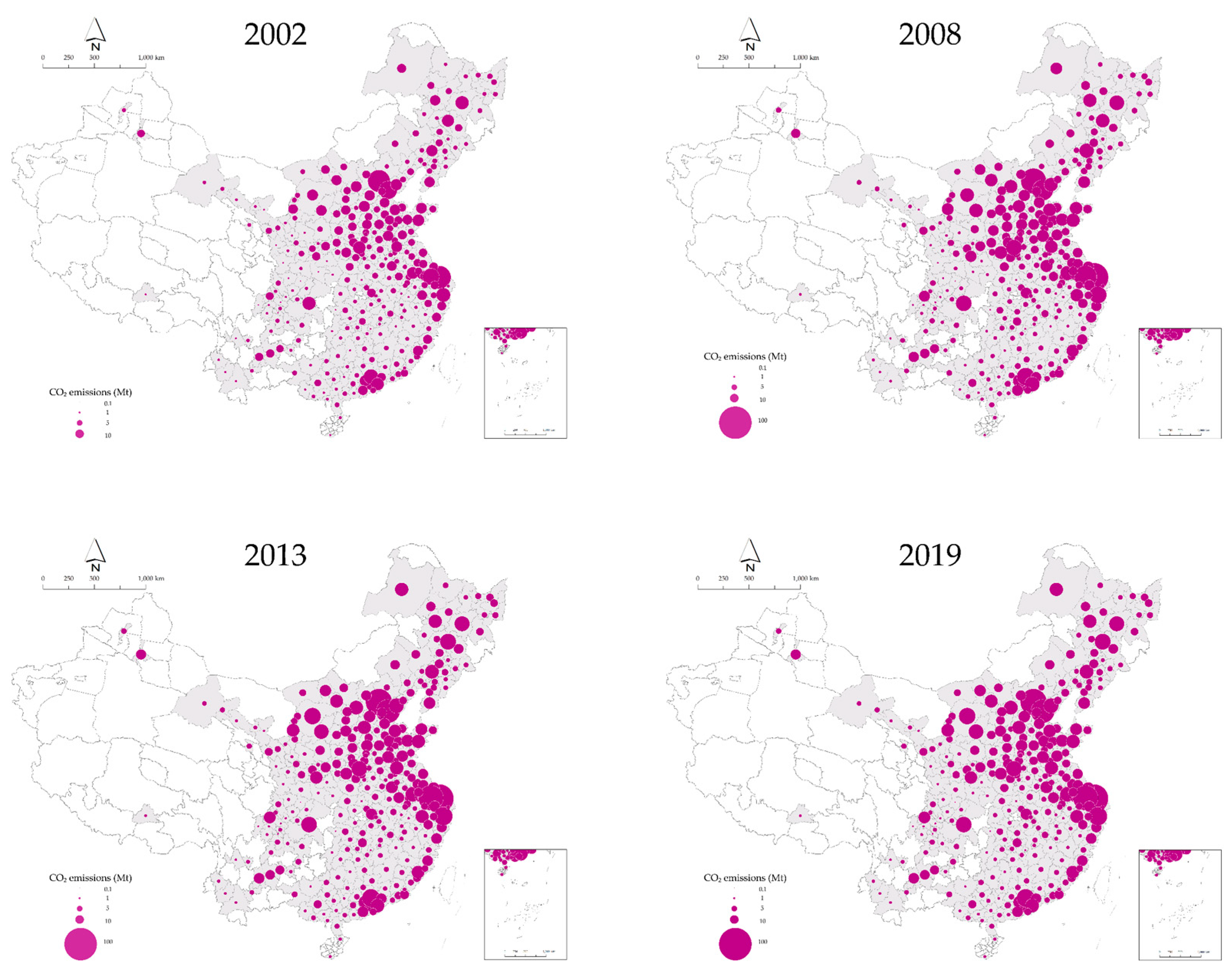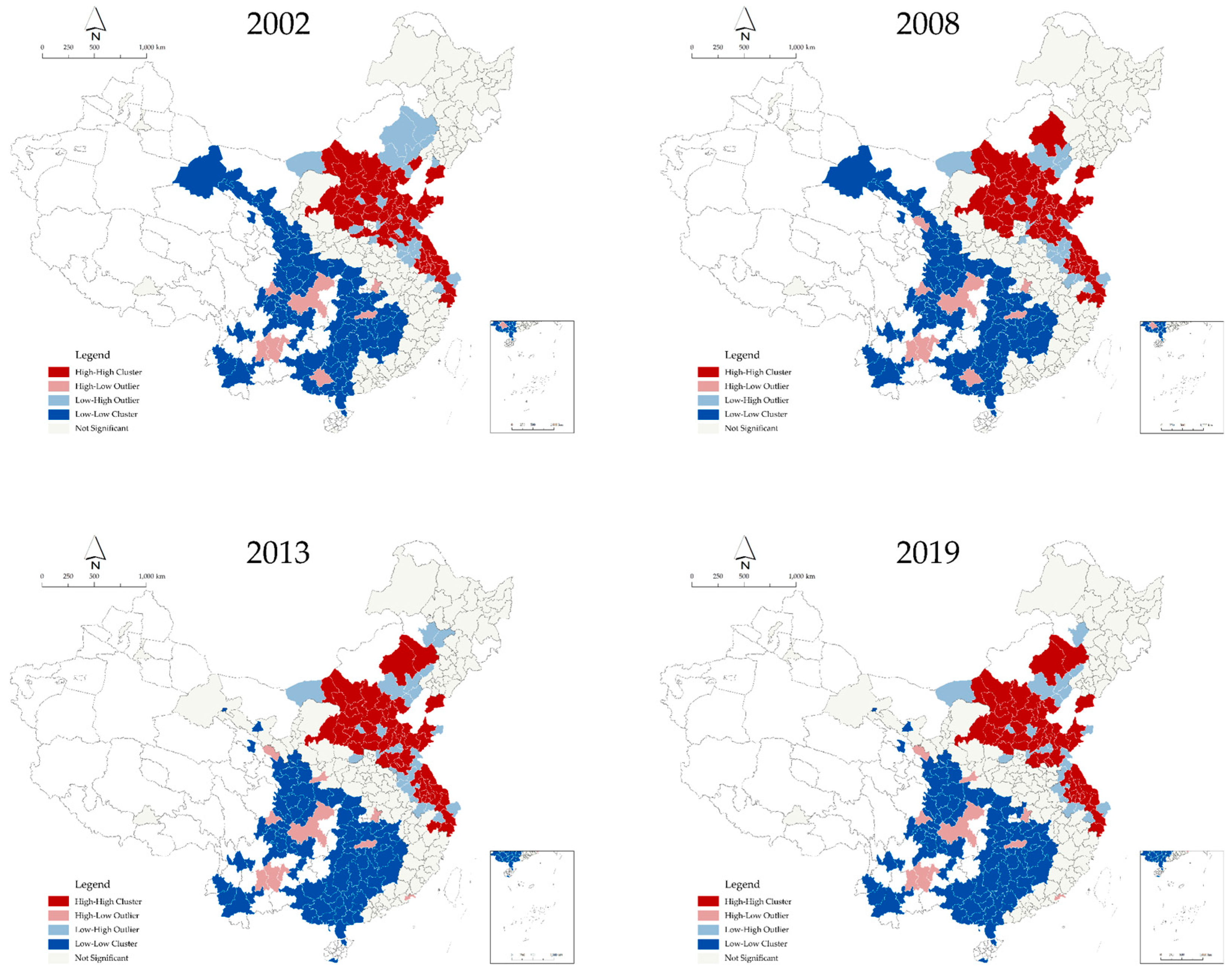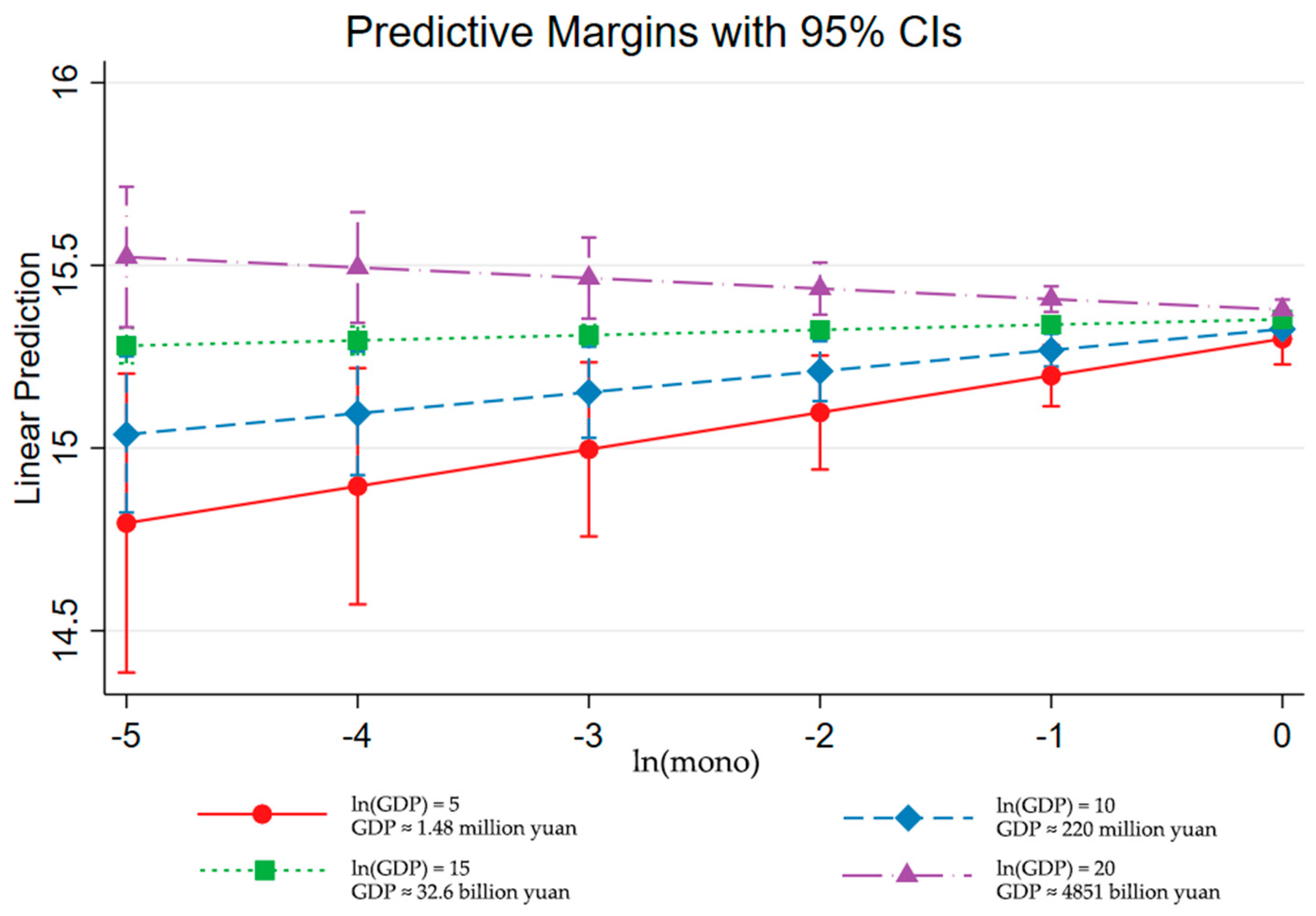Did Polycentric and Compact Structure Reduce Carbon Emissions? A Spatial Panel Data Analysis of 286 Chinese Cities from 2002 to 2019
Abstract
:1. Introduction
2. Materials and Methods
2.1. Estimating Carbon Emissions of Chinese Cities
2.2. Measuring Urban Polycentricity and Compactness
2.3. Regression Models
2.4. Moderating Effect and Spatial Effect
3. The Evolution of Carbon Emissions and Urban Spatial Structure of Chinese Cities
3.1. The Evolving Spatial Distribution of Carbon Emissions
3.2. The Evolution of Urban Spatial Structure
4. The Impact of Urban Spatial Structure on Carbon Emissions of Chinese Cities
4.1. Results of Non-Spatial Models
4.2. Results of Spatial Durbin Models
5. Discussion
6. Conclusions
Author Contributions
Funding
Institutional Review Board Statement
Informed Consent Statement
Data Availability Statement
Conflicts of Interest
References
- Jorgenson, A.K. Economic Development and the Carbon Intensity of Human Well-Being. Nat. Clim. Change 2014, 4, 186–189. [Google Scholar] [CrossRef]
- Soytas, U.; Sari, R. Energy Consumption, Economic Growth, and Carbon Emissions: Challenges Faced by an EU Candidate Member. Ecol. Econ. 2009, 68, 1667–1675. [Google Scholar] [CrossRef]
- Wang, S.J.; Liu, X.P.; Zhou, C.S.; Hu, J.C.; Ou, J.P. Examining the Impacts of Socioeconomic Factors, Urban Form, and Transportation Networks on CO2 Emissions in China’s Megacities. Appl. Energy 2017, 185, 189–200. [Google Scholar] [CrossRef]
- Zhang, Y.J.; Liu, Z.; Zhang, H.; Tan, T.D. The Impact of Economic Growth, Industrial Structure and Urbanization on Carbon Emission Intensity in China. Nat. Hazards 2014, 73, 579–595. [Google Scholar] [CrossRef]
- Shahbaz, M.; Solarin, S.A.; Sbia, R.; Bibi, S. Does Energy Intensity Contribute to CO2 Emissions? A Trivariate Analysis in Selected African Countries. Ecol. Indic. 2015, 50, 215–224. [Google Scholar] [CrossRef] [Green Version]
- Wang, Y.; Zhang, X.; Kubota, J.; Zhu, X.; Lu, G. A Semi-Parametric Panel Data Analysis on the Urbanization-Carbon Emissions Nexus for OECD Countries. Renew. Sustain. Energy Rev. 2015, 48, 704–709. [Google Scholar] [CrossRef]
- Zhang, N.; Yu, K.; Chen, Z. How Does Urbanization Affect Carbon Dioxide Emissions? A Cross-Country Panel Data Analysis. Energy Policy 2017, 107, 678–687. [Google Scholar] [CrossRef]
- Wu, Y.; Shen, J.; Zhang, X.; Skitmore, M.; Lu, W. The Impact of Urbanization on Carbon Emissions in Developing Countries: A Chinese Study Based on the U-Kaya Method. J. Clean. Prod. 2016, 135, 589–603. [Google Scholar] [CrossRef] [Green Version]
- Zhang, F.; Deng, X.Z.; Phillips, F.; Fang, C.L.; Wang, C. Impacts of Industrial Structure and Technical Progress on Carbon Emission Intensity: Evidence from 281 Cities in China. Technol. Forecast. Soc. Change 2020, 154, 119949. [Google Scholar] [CrossRef]
- Li, L.; Hong, X.; Peng, K. A Spatial Panel Analysis of Carbon Emissions, Economic Growth and High-Technology Industry in China. Struct. Change Econ. Dyn. 2019, 49, 83–92. [Google Scholar] [CrossRef]
- Dong, B.; Ma, X.; Zhang, Z.; Zhang, H.; Chen, R.; Song, Y.; Shen, M.; Xiang, R. Carbon Emissions, the Industrial Structure and Economic Growth: Evidence from Heterogeneous Industries in China. Environ. Pollut. 2020, 262, 114322. [Google Scholar] [CrossRef]
- Lee, S.; Lee, B. The Influence of Urban Form on GHG Emissions in the US Household Sector. Energy Policy 2014, 68, 534–549. [Google Scholar] [CrossRef]
- Xu, C.; Haase, D.; Su, M.; Yang, Z. The Impact of Urban Compactness on Energy-Related Greenhouse Gas Emissions across EU Member States: Population Density vs Physical Compactness. Appl. Energy 2019, 254, 113671. [Google Scholar] [CrossRef]
- Fragkias, M.; Lobo, J.; Strumsky, D.; Seto, K.C. Does Size Matter? Scaling of CO2 Emissions and US Urban Areas. PLoS ONE 2013, 8, e64727. [Google Scholar] [CrossRef]
- Liu, X.; Wang, M.; Qiang, W.; Wu, K.; Wang, X. Urban Form, Shrinking Cities, and Residential Carbon Emissions: Evidence from Chinese City-Regions. Appl. Energy 2020, 261, 114409. [Google Scholar] [CrossRef]
- Muniz, I.; Dominguez, A. The Impact of Urban Form and Spatial Structure on per Capita Carbon Footprint in US Larger Metropolitan Areas. Sustainability 2020, 12, 389. [Google Scholar] [CrossRef] [Green Version]
- Wang, S.; Wang, J.; Fang, C.; Li, S. Estimating the Impacts of Urban Form on CO2 Emission Efficiency in the Pearl River Delta, China. Cities 2019, 85, 117–129. [Google Scholar] [CrossRef]
- Veneri, P. Urban Polycentricity and the Costs of Commuting: Evidence from Italian Metropolitan Areas. Growth Chang. 2010, 41, 403–429. [Google Scholar] [CrossRef]
- Ewing, R.; Rong, F. The Impact of Urban Form on US Residential Energy Use. Hous. Policy Debate 2008, 19, 1–30. [Google Scholar] [CrossRef]
- Zheng, S.; Wang, R.; Glaeser, E.L.; Kahn, M.E. The Greenness of China: Household Carbon Dioxide Emissions and Urban Development. J. Econ. Geogr. 2011, 11, 761–792. [Google Scholar] [CrossRef] [Green Version]
- Liu, Y.; Gao, C.; Lu, Y. The Impact of Urbanization on GHG Emissions in China: The Role of Population Density. J. Clean. Prod. 2017, 157, 299–309. [Google Scholar] [CrossRef]
- Mohajeri, N.; Gudmundsson, A.; French, J.R. CO2 Emissions in Relation to Street-Network Configuration and City Size. Transp. Res. Part D Transp. Environ. 2015, 35, 116–129. [Google Scholar] [CrossRef]
- Wang, M.; Madden, M.; Liu, X. Exploring the Relationship between Urban Forms and CO2 Emissions in 104 Chinese Cities. J. Urban Plan. Dev. 2017, 143, 04017014. [Google Scholar] [CrossRef]
- Debbage, N.; Shepherd, J.M. The Urban Heat Island Effect and City Contiguity. Comput. Environ. Urban Syst. 2015, 54, 181–194. [Google Scholar] [CrossRef]
- Fang, C.; Wang, S.; Li, G. Changing Urban Forms and Carbon Dioxide Emissions in China: A Case Study of 30 Provincial Capital Cities. Appl. Energy 2015, 158, 519–531. [Google Scholar] [CrossRef]
- Ou, J.; Liu, X.; Li, X.; Chen, Y. Quantifying the Relationship between Urban Forms and Carbon Emissions Using Panel Data Analysis. Landsc. Ecol. 2013, 28, 1889–1907. [Google Scholar] [CrossRef]
- Echenique, M.H.; Hargreaves, A.J.; Mitchell, G.; Namdeo, A. Growing Cities Sustainably: Does Urban Form Really Matter? J. Am. Plan. Assoc. 2012, 78, 121–137. [Google Scholar] [CrossRef]
- Gaigné, C.; Riou, S.; Thisse, J.-F. Are Compact Cities Environmentally Friendly? J. Urban Econ. 2012, 72, 123–136. [Google Scholar] [CrossRef]
- Sha, W.; Chen, Y.; Wu, J.; Wang, Z. Will Polycentric Cities Cause More CO2 Emissions? A Case Study of 232 Chinese Cities. J. Environ. Sci. 2020, 96, 33–43. [Google Scholar] [CrossRef]
- Li, Y.; Xiong, W.; Wang, X. Does Polycentric and Compact Development Alleviate Urban Traffic Congestion? A Case Study of 98 Chinese Cities. Cities 2019, 88, 100–111. [Google Scholar] [CrossRef]
- Li, Y.; Liu, X. How Did Urban Polycentricity and Dispersion Affect Economic Productivity? A Case Study of 306 Chinese Cities. Landsc. Urban Plan. 2018, 173, 51–59. [Google Scholar] [CrossRef]
- Li, Y.; Zhu, K.; Wang, S. Polycentric and Dispersed Population Distribution Increases PM2.5 Concentrations: Evidence from 286 Chinese Cities, 2001–2016. J. Clean. Prod. 2020, 248, 119202. [Google Scholar] [CrossRef]
- Wang, S.; Shi, C.; Fang, C.; Feng, K. Examining the Spatial Variations of Determinants of Energy-Related CO2 Emissions in China at the City Level Using Geographically Weighted Regression Model. Appl. Energy 2019, 235, 95–105. [Google Scholar] [CrossRef]
- Li, J.; Li, S. Energy Investment, Economic Growth and Carbon Emissions in China—Empirical Analysis Based on Spatial Durbin Model. Energy Policy 2020, 140, 111425. [Google Scholar] [CrossRef]
- Lv, Q.; Liu, H.; Wang, J.; Liu, H.; Shang, Y. Multiscale Analysis on Spatiotemporal Dynamics of Energy Consumption CO2 Emissions in China: Utilizing the Integrated of DMSP-OLS and NPP-VIIRS Nighttime Light Datasets. Sci. Total Environ. 2020, 703, 134394. [Google Scholar] [CrossRef]
- Hwang, Y.; Schlüter, S.; Choudhury, T.; Um, J.-S. Comparative Evaluation of Top-Down GOSAT XCO2 vs. Bottom-Up National Reports in the European Countries. Sustainability 2021, 13, 6700. [Google Scholar] [CrossRef]
- Oda, T.; Maksyutov, S. A Very High-Resolution (1 Km × 1 Km) Global Fossil Fuel CO2 Emission Inventory Derived Using a Point Source Database and Satellite Observations of Nighttime Lights. Atmos. Chem. Phys. 2011, 11, 543–556. [Google Scholar] [CrossRef] [Green Version]
- Hwang, Y.; Um, J.-S.; Schlüter, S. Evaluating the Mutual Relationship between IPAT/Kaya Identity Index and ODIAC-Based GOSAT Fossil-Fuel CO2 Flux: Potential and Constraints in Utilizing Decomposed Variables. Int. J. Environ. Res. Public Health 2020, 17, 5976. [Google Scholar] [CrossRef]
- Oda, T.; Maksyutov, S.; Andres, R.J. The Open-Source Data Inventory for Anthropogenic CO2, Version 2016 (ODIAC2016): A Global Monthly Fossil Fuel CO2 Gridded Emissions Data Product for Tracer Transport Simulations and Surface Flux Inversions. Earth Syst. Sci. Data 2018, 10, 87–107. [Google Scholar] [CrossRef] [Green Version]
- Li, Y.; Derudder, B. Dynamics in the Polycentric Development of Chinese Cities, 2001–2016. Urban Geogr. 2020, 1–21. [Google Scholar] [CrossRef]
- Li, C.; Wu, K.; Gao, X. Manufacturing industry agglomeration and spatial clustering: Evidence from Hebei Province, China. Environ. Dev. Sustain. 2020, 22, 2941–2965. [Google Scholar] [CrossRef]
- LeSage, J.P.; Pace, R.K. The Biggest Myth in Spatial Econometrics. Econometrics 2014, 2, 217–249. [Google Scholar] [CrossRef] [Green Version]




| Variables | Obs. | Mean | Std. Dev | Min | Max |
|---|---|---|---|---|---|
| ln_emissions | 5148 | 15.34 | 0.944 | 12.16 | 18.19 |
| ln_mono | 5148 | −0.361 | 0.346 | −4.371 | 0 |
| ln_disp | 5148 | −0.332 | 0.260 | −2.173 | 0 |
| ln_consume | 5099 | 14.93 | 1.247 | 5.472 | 18.88 |
| ln_GDP | 5128 | 15.98 | 1.182 | 6.016 | 19.76 |
| ln_road_den | 5148 | −0.388 | 0.716 | −4.055 | 1.444 |
| ln_popu_den | 5116 | 7.809 | 0.898 | 3.296 | 9.908 |
| DV: | Non-Spatial Model | Spatial Durbin Model | ||
|---|---|---|---|---|
| Model with Fixed Effect | Model with Moderating Effect | Model with Spatial Lag | ||
| (1) | (2) | (3) | (4) | |
| ln_mono | 0.012 ** | 0.144 ** | −0.006 | |
| (0.005) | (0.066) | (0.005) | ||
| ln_disp | −0.127 *** | −0.128 *** | −0.086 *** | |
| (0.022) | (0.022) | (0.016) | ||
| ln_GDP | 0.009 *** | 0.008 *** | 0.005 | 0.003 ** |
| (0.003) | (0.003) | (0.003) | (0.001) | |
| ln_consume | 0.013 ** | 0.013 ** | 0.013 ** | −0.002 |
| (0.006) | (0.006) | (0.006) | (0.004) | |
| ln_pop_den | 0.012 *** | 0.012 *** | 0.012 *** | 0.013 *** |
| (0.002) | (0.002) | (0.002) | (0.003) | |
| ln_road_den | 0.024 *** | 0.027 *** | 0.028 *** | 0.071 *** |
| (0.007) | (0.007) | (0.007) | (0.010) | |
| ln_mono_ln_GDP | −0.009 ** | |||
| (0.004) | ||||
| Wln_mono | 0.701 *** | |||
| (0.093) | ||||
| Wln_disp | 0.462 *** | |||
| (0.123) | ||||
| Wln_GDP | −0.024 * | |||
| (0.013) | ||||
| Wln_consume | −0.131 *** | |||
| (0.011) | ||||
| Wln_pop_den | 0.589 *** | |||
| (0.064) | ||||
| Wln_road_den | 1.501 *** | |||
| (0.081) | ||||
| Constant | 14.934 *** | 14.911 *** | 14.953 *** | 0.035 *** |
| (0.097) | (0.097) | (0.099) | (0.000) | |
| SAR(H0) vs. SDM LR spatial lag | 5855.63 *** | |||
| SEM(H0) vs. SDM LR spatial error | −1269.23 | |||
| Observations | 5075 | 5075 | 5075 | 4004 |
| R-squared | 0.992 | 0.992 | 0.992 | |
| Year FE | YES | YES | YES | NO |
| City FE | YES | YES | YES | YES |
| Variable | Direct Effect | Indirect Effect | Total Effect |
|---|---|---|---|
| ln_mono | −0.006 | 0.648 *** | 0.642 *** |
| ln_disp | −0.087 *** | 0.427 *** | 0.341 *** |
| ln_GDP | 0.003 ** | −0.022 * | −0.019 * |
| ln_consume | −0.002 | −0.121 *** | −0.123 *** |
| ln_pop_den | 0.013 *** | 0.545 *** | 0.558 *** |
| ln_road_den | 0.071 *** | 1.388 *** | 1.459 *** |
Publisher’s Note: MDPI stays neutral with regard to jurisdictional claims in published maps and institutional affiliations. |
© 2022 by the authors. Licensee MDPI, Basel, Switzerland. This article is an open access article distributed under the terms and conditions of the Creative Commons Attribution (CC BY) license (https://creativecommons.org/licenses/by/4.0/).
Share and Cite
Zhu, K.; Tu, M.; Li, Y. Did Polycentric and Compact Structure Reduce Carbon Emissions? A Spatial Panel Data Analysis of 286 Chinese Cities from 2002 to 2019. Land 2022, 11, 185. https://doi.org/10.3390/land11020185
Zhu K, Tu M, Li Y. Did Polycentric and Compact Structure Reduce Carbon Emissions? A Spatial Panel Data Analysis of 286 Chinese Cities from 2002 to 2019. Land. 2022; 11(2):185. https://doi.org/10.3390/land11020185
Chicago/Turabian StyleZhu, Kai, Manya Tu, and Yingcheng Li. 2022. "Did Polycentric and Compact Structure Reduce Carbon Emissions? A Spatial Panel Data Analysis of 286 Chinese Cities from 2002 to 2019" Land 11, no. 2: 185. https://doi.org/10.3390/land11020185
APA StyleZhu, K., Tu, M., & Li, Y. (2022). Did Polycentric and Compact Structure Reduce Carbon Emissions? A Spatial Panel Data Analysis of 286 Chinese Cities from 2002 to 2019. Land, 11(2), 185. https://doi.org/10.3390/land11020185






